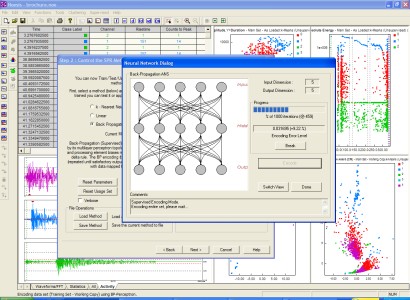|
    
Previous
Page |
Noesis Main Page
| Next
Page
Noesis
Supervised Pattern Recognition (SPR)

Supervised Pattern
Recognition (SPR) is the process by which a data set is partitioned into
various groups (clusters) using the properties of an "example" partitioning in
some other data. This assumes that some data with the a desired
clustering (partitioning) has previously been achieved (manually
or via
Unsupervised Pattern Recognition methods).
The SPR algorithm is then trained, based on this known data set and
partitioning. Once trained, the algorithm can partition new data to clusters
similar to those of the example classification. All
necessary
preprocessing of the new data is also done automatically. Trained
algorithms can be saved to (or retrieved from) files. The user has control over
several parameters and can investigate the effectiveness of the training
process (how well the algorithm is trained). All actions are easily undone to
provide a high level of flexibility and user friendliness. Several SPR
algorithms (including neural networks) are included. Following is a list of
some of the basic functions and features available with Noesis' SPR:
-
SPR Wizard allowing
the user to easily "cruise" through the various choices to train an SPR method
(classifier). The wizard provides all relevant information (method, parameters
etc) so that SPR training and results overview becomes simple.
-
Automatic Usage Set (unknown
data) pre-processing based on Noesis Script Log (feature
selection, normalization, feature extraction etc.).
-
Multiple SPR algorithms
including Neural Networks (k-NNC, BP Net etc.).
-
Interactive SPR algorithm
training and testing modes.
-
Multi-mode independent Training
and Testing data sets.
-
Classification result output
to PAC (DTA, TDA or WFS) files (see also
Data Handling).
-
Descriptive statistics for
clustering evaluation (see also
Statistics).
|